City trip Granada
Alhambra, Generalife and Albaicín
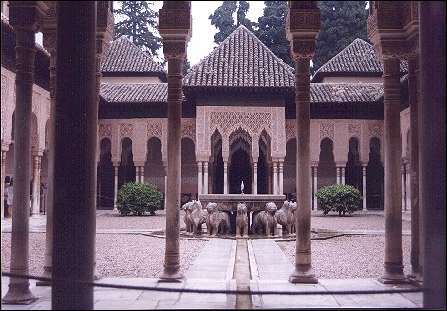
|
The Moorish palaces of the Alhambra and Generalife all by themselves are reason enough to spend a few days in Granada. But this city has more to offer, like the largest Moorish Quarter in Spain. It also is a lively university city with lots of squares with outdoor cafés.
Travelogue & photos: Piet de Geus
Granada, nowadays a lively university city despite mass tourism, became the capital of Moorish Spain after Córdoba was conquered by the Christians. Until it also fell into the hands of the reconquistadores in 1492, its rulers kept building palaces in the Alhambra, a 2100 feet (700 m) long fortress on a hill top above the city.
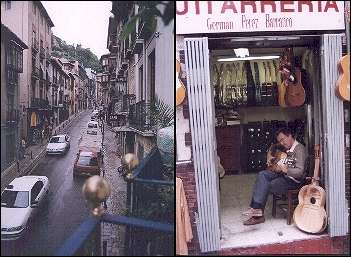
|
From the central square Plaza Nueva the 16th century Cuesta de Gomérez leads to the Alhambra. This crowded street is so narrow that traffic lights direct traffic alternately up and down.
It's one souvenir shop after another, some of which have workshops where different kinds of wood are being processed into covers for jewelry boxes and game card boxes, mirror frames and even side tables. It's a sophisticated way of decorating, clearly of Eastern origins.
There are also ten or so builders of Spanish guitars in this street. After the siesta the (sometimes famous) customers try out their instruments and if not, the builders themselves will play the guitar, accompanied by their wives on castanets.
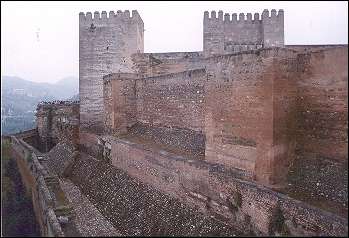
|
The street ends in the Puerta de las Granadas, a Renaissance gate through which you enter the cool, dark park that surrounds the Alhambra. A path ascends along fountains and splashing streams to the main entrance, the impressive Puerta de la Justitia.
Inside the gate you have to change direction three times, which must have made the defense of the fortress easier. Furthermore you could be sure to be doused with boiling oil and molten lead from the walls. The access roads are narrow and steep on purpose, so a quick massive attack was not an option either.
The Alcazaba
The Old Citadel
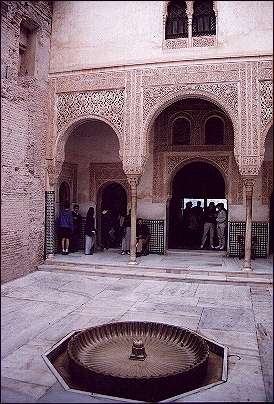
|
The oldest part of the Alhambra is the Alcazaba. This citadel was the first one built after the Moorish invasion in 711, on top of the remains of a Roman stronghold. After the fall of Córdoba, Granada became the capital of Moorish Spain in the dynasty of the Nasriden, who moved to the South after the loss of Zaragoza.
The first Nasriden king rebuilt the Alcazaba, added enormous double walls with impressive defense towers, which were supposed to compensate for the political weakness of the Nasriden. The highest tower, Torre de la Vela, offers great views of the the Alhambra and the rest of Granada to the Vega and on the other side the snow-covered peaks of the Sierra Nevada. Within the walls he erected a palace.
This Nasriden king moreover provided running water for the Alhambra, by rerouting a branch of the Rio Darro for 6 miles (8 km) to the foot of the hill. Water is everywhere in the Alhambra and its many gardens: everywhere it gurgles and splashes, there are streams, fountains and ponds.
The Moors were masters of water engineering including the use of water pressure. In the Alpujarres, a valley on the other side of the Sierra Nevada, the irrigated terraces that were constructed by the Moors, are still functioning. Because they needed their water engineering skills, even a century after the Inquisition began, it was still allowed for every village to have two Moorish families live there.
Decay and Repair
Saved in the nick of time by a crippled soldier
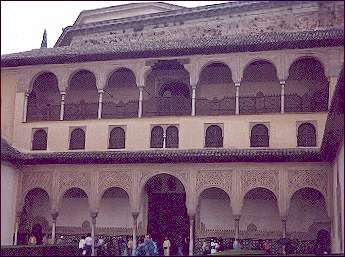
|
The successive Nasriden kings built an unparallelled palace complex within the walls of the Alhambra. Inside the citadel moreover sprung up a complete residence with schools, mosques, barracks and gardens, where 40.000 people lived. Only the Alcazaba fortifications and the royal palace have survived.
After the "liberation" the Alhambra slowly fell to ruins. King Carlos V, who also did a lot of damage in Córdoba and Sevilla, thought it necessary to demolish a complete wing of the palace to build another superfluous Renaissance palace. His successors ignored the Alhambra as well as this new palace, which was used as a prison in the 18th century. In 1812 the compound was occupied by Napoleon's army, who looted an sacked it. When they were leaving Granada, they even intended to blow it up, but that plan was foiled in the nick of time by a crippled soldier who lagged behind and removed the fuses.
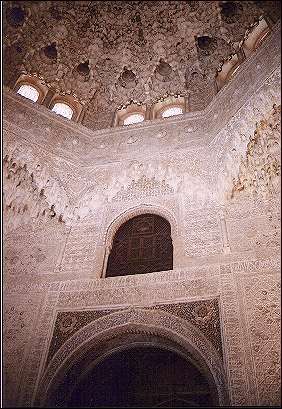
|
This soldier is commemorated in the Alhambra, even as the American novelist Washington Irving, who discovered the structure and made his study in one of the empty rooms of the palace. There he wrote his famous and romantic novel Tales of the Alhambra. Shortly after its publication the Alhambra became a national monument that is being cared for conscientiously and with academic responsibility.
Later additions are being removed to be able to show, after meticulous renovation, the original Moorish creations. Your entrance fee is well spent - although I wonder whether they'll go as far as demolishing the Palacio Carlos V, the Convento de San Fransisco and the Iglesia Santa Maria.
The Nasriden Palaces
Not for eternity
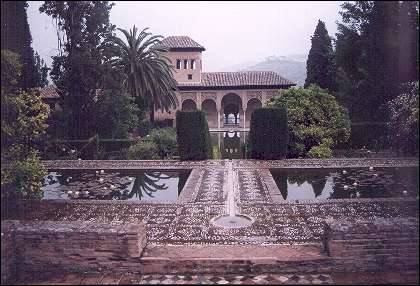
|
It's a miracle already that the Casa Real survived. In contrast with the surrounding walls and towers it is a sophisticated and vulnarable building. It was mainly a vehicle for the ornamental stucco decorations.
It wasn't intended for eternity to begin with. The idea was, that successive rulers would innovate and redecorate. This was their philosophy about abstract art as well as about their highly developed science.
The palace compound has three parts, each of them clustered around its own patio. The Mexuar housed the economic and legal departments of the kingdom. The Serallo was the residence of the Sultan where he received important guests. In the Harem were private quarters, only open to family and servants. Walking around the compound, your jaw keeps dropping: it is so sophisticated and refined! And the next room could surpass even this one...
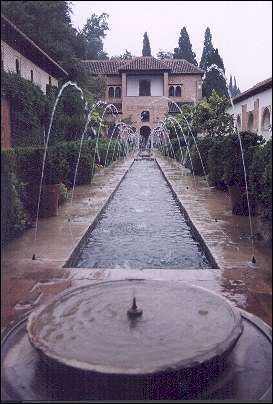
|
Via the royal baths you eventually reach the amazingly pretty gardens of the Partal. And then there are also lots of richly decorated towers and gates within the walls. It is too much to take in in one visit; you need to spend more than a day here. From the garden design to the busiest decorations, it all is extremely restful.
However overwhelming, none of this is screaming for attention: a priciple of Moorish non-figurative art with its rythmic repetitions, is that it should symbolize the unity of Allah, who is present in everything. Because of that, there is no attempt to lead the gaze to one central message, like in the Christian tradition, but to convey a state of mind. I have to admit that it works: strolling here works as a meditation.
The Generalife
The Sultans' Summer Palace
As if there wasn't enough to see already, on the next hill top there is the Generalife: the gardens and the Summer Palace of the Sultans. It's a wonderful maze of buildings with slender columns, patios, open and secluded gardens and passways, alternating between dark and light, just like the palaces. And of course there are all these ponds and fountains. The Generalife is in and by itself an overwhelming complex and on top of that it has a view of the Alhambra on the other hill.
The Albaicín
The largest Moorish Quarter of Spain
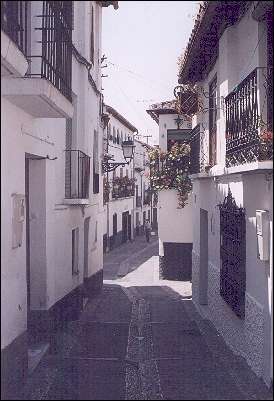
|
Even though the Alhambra doubtlessly is the main reason to visit Granada, the city has much more to offer. In the first place there is, on a hill on the other side of the river, Rio Darro, the Albaicín, the largest Moorish quarter in Spain. This part of town was also surrounded by a wall and large sections of it still exist.
From the Plaza Nueva the Carrera del Darro runs along the river of the same name. The river disappears into nothingness near the square: it goes underground. Two exquisite stone bridges, named after Cabrera en Espinosa, lead to a row of houses on the other side of the river. Behind those houses is the wooded hill above which tower the walls of the Alhambra.
In this street are the Moorish bath houses. Until the end of the 19th century they were in use as laundries. Immediately after the Reconquista they had lost their original purpose, because one of the first laws the new Catholic rulers imposed, was to make bathing a punishable offense.
The entrance to the baths is on the flower-covered patio of a house. An elderly woman explains the purposes of the different rooms, in Spanish. But even without knowledge of this language we could easily understand in which rooms were the cold baths, which were the steam rooms, where the massages were given and debates about politics and religion took place. The rooms with Roman and Visigothic marble columns are illuminated through star-shaped recesses in the roof.
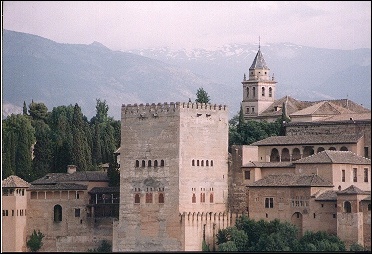
|
On the Carrero del Darro and the steep streets to the left of the Albaicín a few original Moorish city houses still survive. The bell tower of the Iglesia de Santa Ana, at the beginning of the street, is - like so many in Andalusië - a converted minaret.
A little past the baths is the Archeological Museum, housed in Casa de Castril, which shows objects from all over this province: from the era of the Neolithic graves (4000 BC), through the Iberians, Phoenicians, Romans and Visigoths to the Moors. Instructive scale-models and drawings show how people lived in the different periods and what the functions were of the excavated objects. Looking up from the patio you can see the Alhambra even here.
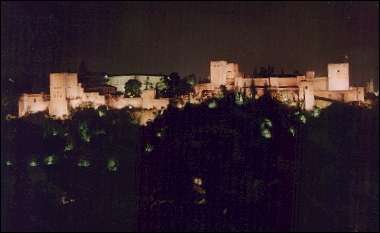
|
Crossing the street in the Paseo de Padre Manjón (also called Paseo de los Tristes) the buildings make place for woods. The street is an esplanade with terraces that offer a great view of the huge walls on the other side. At night those walls are even illuminated with floodlights.
A little further the street changes its name again. Now it's Cuesta del Chapiz, after the 16th century Moorish city palace Casa del Chapiz, which nowadays aptly houses the School for Arabic Studies. The road climbs in a wide bend to the city walls and the cave dwellings of the Gypsy quarter Sacromonte: the Flamenco bars and discotheques here are tourist traps, but if you feel the need you can get yourselves ripped off here.
Behind a gate in the Cuesta del Chapiz are the City Archives in a palace with a big garden. It's not a museum, but you can go in to admire the gorgeous patio.
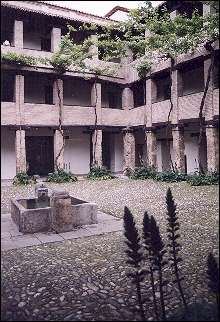
|
Albaicín is a maze of streets, stairs and intimate squares. It's wonderful to stroll along here aimlessly, in the end you'll end up in the highest part anyway. An ideal spot to rest and maybe have a picnic is Mirador S. Nicolás. Ignore the busloads of tourists who walk by as well as the hippies who hang out here and enjoy the amazing view of the Alhambra, Granada and the Sierra Nevada. Come back when it's dark: there is no other place where you have a better view of the illuminated walls and palaces. Nearby is a small 15th century church with one of the original Moorish fountains next to it. Every mosque had one and there were over 30 mosques in this part of town.
An interesting square to visit is the Plaza San Miguel Bajo, where the 16th century Monasterio de Santa Isabel la Real sits, built partly inside a Nasriden palace. Only the patios and some arches of the palace itself have survived.
The living heart of the neighborhood is the Plaza Largo, around which some of the prettiest streets are. In the daytime the square is a vegetable and fruit market, in the evening the stalls make place for outdoor cafés. On the edge of the square is a beautiful gate, the Arco de las Pesas.
Downtown
Dominated by an enormous Renaissance cathedral
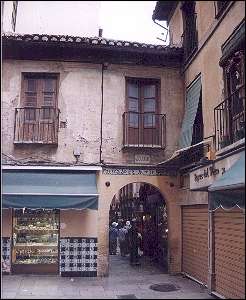
|
Even outside Albaicín you can find some remains of the Moorish era. The Tourist Office is housed in the Corral del Carbón, a 14th century caravansarai, which is unique in Spain. In this inn traders spent the night, their goods were stored on the upper floors.
Alcaícería is the former Arabic silk market. Now it is an arcade full of souvenir shops, pretentiously named 'Mercado de Artisania'.
Downtown is dominated by a huge Renaissance cathedral, the construction of which was started in 1521 and completed only in the 18th century. Next to it is the older, late-Gothic Capilla Real, the royal chapel.
Isabel and Ferdinand are buried here, the king and queen who are commemorated all over the country with streets, squares and statues as Los Reyes Católicos (the Catholic kings). Kings of the Inquisition would be a more correct name for the "liberators" of the city. At their feet is the inscription, in Latin: "Overthrowers of the Mohammedan sect and suppressers of heretic stubbornness."
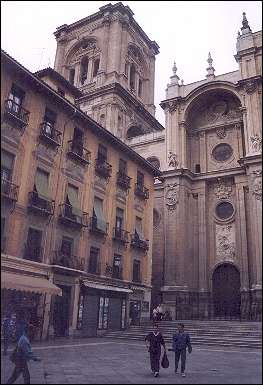
|
The way the chapel is decorated shows exactly what that victory meant: Moorish sophistication was replaced with Roman-Catholic nagging and unembarrassed gaudiness. Looking at the Jesuses of the Flemish masters from Isabel's private collection of paintings I can only think: he got away easily by just being crucified.
Near the cathedral is a nice square, Plaza Bib-Rambla, with outdoor cafés between the flower stalls. Another pleasant square is the nearby Plaza Trinidad, which looks French with its shady park and fountain. Plaza Nuevo is less attractive, with busy traffic and loads of tourist buses. The restaurants around here are real tourist traps. The same goes for the ones around Campo Principe. Realejo on the other hand, the neighborhood between this square and Plaza Nuevo, is very atmospheric with its steep streets.